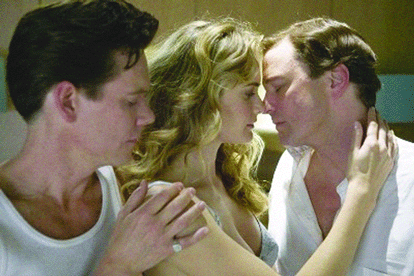Queer sex, Kevin Bacon, Colin Firth, but also something missing
It is a shame that “Where the Truth Lies” is getting so much unwarranted attention for the queer three-way sex scene that caused censors grief. A shame because the scene in question is a critical plot point, and viewers who wait in anticipation for the famous moment will find some of the film’s pleasures spoiled in the process. What is more, another same-sex love scene is far more titillating and revealing about the characters.
That said, “Where the Truth Lies,” written and directed by Atom Egoyan, and adapted from Rupert Holmes’ novel, is engrossing and enjoyable, but it is certainly not the director’s best work. Arguably, “The Sweet Hereafter” is.
Egoyan’s signature style is to slowly reveal the narrative, unfolding it in layers, as if peeling an onion. This film is no exception, and it features no less than three narrators—all central figures in the drama. Each takes their turn telling a different side of the story, and what is compelling is how they shift identities—or reality—to make themselves heard. It is as if the protagonists need to convince Because the plot concerns an unsolved murder, is it fair play to question the reliability of the narrators. Egoyan shrewdly makes everyone suspect, and in the process, achieves pulpy, neo-noir fun with the film.
Lanny Morris (Kevin Bacon) and Vince Collins (Colin Firth) are a “Lewis and Martin”-like lounge act in the 1950s. The pair host a Veteran’s Day polio telethon, and one child guest, Karen O’Connor (Alison Lohman), idolizes them. Egoyan buries the connection among these three characters for a little while, but it soon becomes clear that this is the where the story begins.
Much of the action, however, takes place in the 1970s, by which time Karen has become a journalist hoping to interview Vince for a book and perhaps learn why the duo broke up suddenly after so much tremendous success. It may have to do with what happened in Lanny and Vince’s hotel room 15 years before, when a dead body was found in the bathtub.
The mystery of “Where the Truth Lies,” however, is essentially a MacGuffin, as Hitchcock used to call it—a plot device that propels the narrative forward, even though it is ultimately meaningless. Individual episodes are intriguing, and the oblique storytelling holds the audience’s interest, but the whodunit is less important than the how and why. In fact, viewers may decide that the solution to the crime lacks a proper payoff, that it’s more of a yawn than a surprise.
What is most significant is the stylish way Egoyan tells Lanny and Vince’s tale. The filmmaker elevates mediocre material with his terrific eye for period detail. The 1950s scenes are lovingly filmed and a pleasure to watch. For example, an important scene in which Karen coincidentally meets Lanny in the first class section on an airplane is memorable as much for the sight of an elaborate dinner service involving two rows of passengers sharing a table as for the fact that she has assumed a friend’s identity.
The film features top-notch performances from Kevin Bacon and Colin Firth. It’s a bit disconcerting to see Bacon playing Jewish, but he does a terrific job as Lanny. Bacon’s exposition about how naked women act when caught in his bed is amusing, and he deepens his voice between the decades for good effect. Bacon also deftly uses body language to convey his character’s manic antics on stage and off, and apparently, he has no difficulty performing the various sex scenes, which frequently require nudity.
Firth’s part is smaller, but equally well played. Changing his image from the Mr. Darcy roles he’s essayed in the past, Firth shows a new side as Vince, especially when he viciously beats a rude audience member for his bad behavior. It’s exciting to see Firth take on a challenge, and he handles it quite adroitly.
Unfortunately, Alison Lohman’s lousy reading of Karen O’Connor sabotages “Where the Truth Lies.” If Lohman looks the part, she is way out of her league professionally. The actress does not have the gravitas to make Karen a gutsy, scheming reporter, and this is in part why her performance—and to a certain extent, the film—fails. Egoyan crafts “Where the Truth Lies” with such obvious care; it’s a shame let this fatal flaw slip by him.
The film is provocative and daring, but ultimately misses the mark.
gaycitynews.com
































